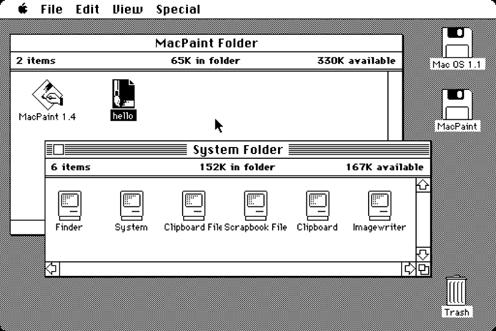The original Mac OS defined the basic metaphors that influenced personal computing and, for a decade, was the standard by which all other personal computer operating systems were measured. It was not until Microsoft Windows 95 was introduced that anything else came close. Unfortunately, while Apple made many mistakes, Microsoft continued to improve Windows and ended up owning the user desktop experience for the last half of the 1990s. Now, with the advent of a technological tour de force known as Mac OS X, the Mac is once again setting the standard for what a personal operating system should be.
The Mac OS as we now know it is far different from the version released in 1984. It is a successful hybrid of ideas that were first expressed in the original Macintosh and of technologies that come from a computing philosophy long considered to be the antithesis of the Mac experience: Unix. The fusion of these two very different camps gives us the platform we know and love today.
Instead of giving the same laundry list of features in this chapter that you can get from Apple’s web site or from most other books covering Mac OS X, I’m going to take a look at the predecessors to Mac OS X and explore the various origins of the modern system. The intent isn’t to tell the story of Apple Computer or Steve Jobs (although those histories are interesting); the focus here is on the technologies at hand, where they came from, and how they influenced the development of the Mac operating system. Each major technology of the current Mac OS X is introduced and its source identified.
In 1983, after the incredible success of the original Apple II (the first true personal computer for most people) and the later relative disappointments of the Apple III and the Lisa , Steve Jobs organized a group of engineers under a pirate flag to make a computer that could be used by anybody.
The result of their efforts, known as the Macintosh, was introduced to the world a year later accompanied by the fanfare of the famous “1984” commercial (directed by Ridley Scott of Alien and Blade Runner fame). With a message of empowerment, the Mac redefined what a personal computer could be. What made the Mac different from every other personal computer at the time was its graphical user interface (GUI) , inspired by research that originated at Xerox PARC : a desktop where files lived in folders, and you used a mouse to move things where you wanted them. The Mac’s original desktop is shown in Figure 1-1.
The desktop metaphor introduced with the original Mac in 1984 lives on today in the current Finder. Sure, today’s desktop is rendered in full color and the original was comparatively crudely drawn in black and white, but the basic idea remains much the same: opening disks and folders yields windows that contain icons that represent files.
At the heart of the system was a set of programmatic routines called the Macintosh Toolbox that allowed programmers to implement the various essential interface components—such as windows, menus, alert boxes, scrollbars, and other controls—in their applications. In 1984, the Toolbox was an amazing feat of engineering and contributed to a consistent user experience that was the envy of other operating system vendors. But, over the years after its release, more and more routines were added to the Toolbox as the system developed. This resulted in more features, but those features came with a price—the system became fragile.
Get Running Mac OS X Tiger now with the O’Reilly learning platform.
O’Reilly members experience books, live events, courses curated by job role, and more from O’Reilly and nearly 200 top publishers.


